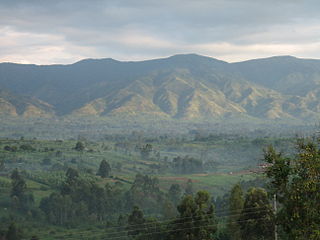
North Kivu is a province bordering Lake Kivu in the eastern Democratic Republic of the Congo. Its capital is Goma. The 2020 population was estimated to be 8,147,400.

South Kivu is one of 26 provinces of the Democratic Republic of the Congo (DRC). Its capital is Bukavu.

Goma is the capital and largest city of the North Kivu Province in the eastern region of the Democratic Republic of the Congo (DRC). It is located on the northern shore of Lake Kivu, next to the Rwandan city of Gisenyi. It shares its borders with Bukumu Chiefdom to the north, Rwanda to the east, Masisi Territory to the west, and is flanked by Lake Kivu to the south. The city lies in the Albertine Rift, the western branch of the East African Rift System, and is only 13–18 km (8.1–11.2 mi) south of the active Nyiragongo Volcano. With an approximate area of 75.72 square kilometers, the city has an estimated population of nearly 2 million people according to the 2022 census, while the 1984 estimate placed the number at 80,000.
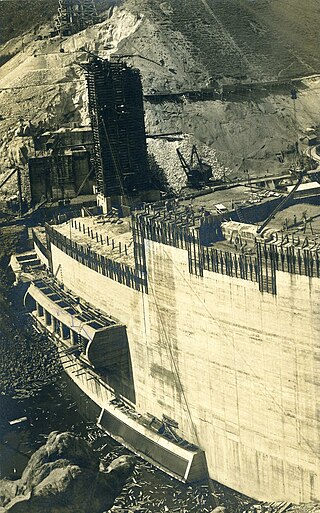
Rutshuru is a town located in the North Kivu province of the eastern Democratic Republic of the Congo, and is headquarters of an administrative district, the Rutshuru Territory. The town lies in the western branch of the Albertine Rift between Lakes Edward and Kivu. The Ugandan border is 15 km east and the Rwandan border is 30 km south-east. Lava flows from the Nyamuragira volcano, 40 km south-west, have come within 7 km of the town in recent years.

Masisi Territory is a territory which is located within the North Kivu Province of the Democratic Republic of the Congo. Its political headquarters are located in the town of Masisi.
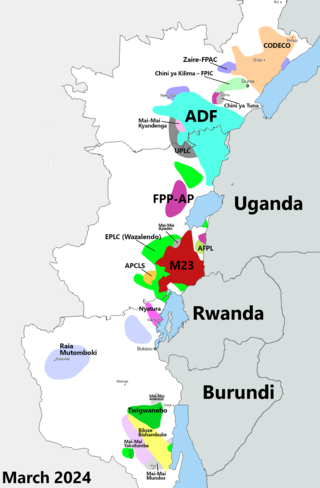
The Kivu conflict is an umbrella term for a series of protracted armed conflicts in the North Kivu and South Kivu provinces in the eastern Democratic Republic of the Congo which have occurred since the end of the Second Congo War. Including neighboring Ituri province, there are more than 120 different armed groups active in the eastern Democratic Republic of Congo. Currently, some of the most active rebel groups include the Allied Democratic Forces, the Cooperative for the Development of the Congo, the March 23 Movement, and many local Mai Mai militias. In addition to rebel groups and the governmental FARDC troops, a number of national and international organizations have intervened militarily in the conflict, including the United Nations force known as MONUSCO, and an East African Community regional force.

The National Congress for the Defence of the People is a political armed militia established by Laurent Nkunda in the Kivu region of the Democratic Republic of the Congo in December 2006. The CNDP was engaged in the Kivu conflict, an armed conflict against the military of the Democratic Republic of the Congo. In January 2009, the CNDP split and Nkunda was arrested by the Rwanda government. The remaining CNDP splinter faction, led by Bosco Ntaganda, was planned to be integrated into the national army.
Kanyabayonga is one of the groupements (groupings) within the Bwito Chiefdom in the Rutshuru Territory of North Kivu Province in the eastern Democratic Republic of the Congo (DRC). The region has suffered from continued violence between the army and rival militias since 1993.

Rutshuru Territory is a territory in the North Kivu province of the eastern Democratic Republic of the Congo (DRC), with headquarters is the town of Rutshuru.

The March 23 Movement, often abbreviated as M23 and also known as the Congolese Revolutionary Army, is a Congolese rebel military group that is for the most part formed of ethnic Tutsi. Based in eastern areas of the Democratic Republic of the Congo (DRC), it operates mainly in the province of North Kivu, which borders both Uganda and Rwanda. The M23 rebellion of 2012 to 2013 against the DRC government led to the displacement of large numbers of people. On 20 November 2012, M23 took control of Goma, a provincial capital with a population of a million people, but it was requested to evacuate it by the International Conference on the Great Lakes Region because the DRC government had finally agreed to negotiate. In late 2012, Congolese troops, along with UN troops, retook control of Goma, and M23 announced a ceasefire and said that it wanted to resume peace talks.

Bunyakiri is a town located in the high plateau of Kalehe Territory in the South Kivu Province in the eastern region of the Democratic Republic of the Congo (DRC). Bunyakiri is nearby the Bulehe and Mulamba villages. It is mainly inhabited by Tembo, Havu, Twa and Hunde ethnic groups.

Lubero is a town in the North Kivu Province of the Democratic Republic of the Congo. It is the administrative center of the Lubero Territory. Following the surrender of the Mai-Mai fighters in 2021, construction of a new market began in 2022, involving the mayor, ex-soldiers, "young people at risk and the vulnerable women". As of March 2014, the population of Lubero is not publicly known.
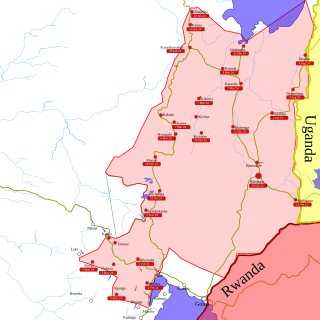
In late March 2022, the March 23 Movement (M23) launched an offensive in North Kivu, clashing with the Armed Forces of the Democratic Republic of the Congo (FARDC) and MONUSCO. The fighting displaced hundreds of thousands of civilians and caused renewed tensions between the Democratic Republic of the Congo and Rwanda, as the latter was proved of supporting the rebel offensive.
Yusufu Eric Mboneza, more commonly called Yusuf Mboneza, is or was a Congolese military officer and rebel. During his career he served in the Rally for Congolese Democracy, the National Congress for the Defence of the People, the Armed Forces of the Democratic Republic of the Congo, and finally the March 23 Movement.

The Rubaya mines, also known as the Bibatama Mining Concession, is a series of coltan mining sites near the town of Rubaya in Masisi Territory, North Kivu, Democratic Republic of the Congo. Officially, the mining license is held by Société Minière de Bisunzu Sarl (SMB), associated with Congolese senator Édouard Mwangachuchu. Specific sites include Bibatama D2, Luwowo, Gakombe D4, Koyi, Mataba D2, Bundjali, and Bibatama D3.
The Kishishe massacre occurred from November 29 to December 1, 2022, in the North Kivu village of Kishishe in the Rutshuru Territory in the eastern Democratic Republic of the Congo. The March 23 Movement, a predominantly Tutsi armed group, summarily killed at least 131 civilians in Kishishe following clashes with local militias, according to a preliminary United Nations investigation. At the same time, the Kinshasa authorities had previously reported approximately 300 fatalities. The attack also resulted in the displacement of hundreds of thousands of people who were forced to flee to other locations such as Kanyabayonga, Kibirizi, Kashala, Kirima, Nyanzale, Kashalira, Bambu, and Kitchanga. Some victims also sought refuge in neighboring countries due to the ongoing violence and instability in the region.
Kinyandonyi is a village in the Rutshuru Territory of the North Kivu Province, Democratic Republic of the Congo. Kinyandonyi is situated 10 km east of the city of Kiwanja in Bukoma groupement, in the Bwisha Chiefdom and 85 km north of the capital of the province Goma. The region is inhabited by the Hunde people as well as some remaining autochthonous populations of African Pygmies, including the Twa people and the Mbuti people. In addition to the Hunde, Twa, and Mbuti, there are other ethnic groups, including the Nyanga, Lega, Kumu, Hutu and Tutsi.

Kitchanga, also known as Kitshanga, is a town and a camp for Congolese Internally Displaced People (IDPs) in the Rutshuru Territory of North Kivu Province in the eastern region of the Democratic Republic of the Congo (DRC). Kitchanga is located 119 kilometers north of Goma and 10 kilometers north of Burungu. It also lies near Kizimba and Budey villages.

Between January 24 and 26, 2023, M23 rebels and Armed Forces of the Democratic Republic of the Congo (FARDC) soldiers fought over the city of Kitshanga. The battle was part of the renewed M23 offensive, and ended on January 26 with M23 forces capturing the city. Civilians accused both M23 and FARDC-aligned militias of war crimes during and after the battle.
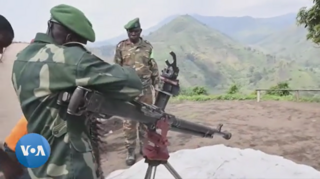
The Second battle of Kitshanga broke out between Rwandan-backed M23 fighters and self-defense groups known as Wazalendo allied with the Congolese government. In January 2023, M23 rebels captured Kitshanga from the Congolese Army and allied forces in their renewed offensive in North Kivu. Wazalendo forces captured Kitshanga in early October 2023 as part of a counteroffensive, with the city switching hands between Wazalendo and the M23 after October 16, and a second M23 offensive on October 21 capturing the town.

















